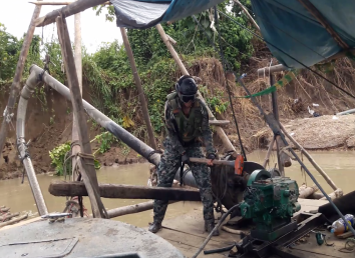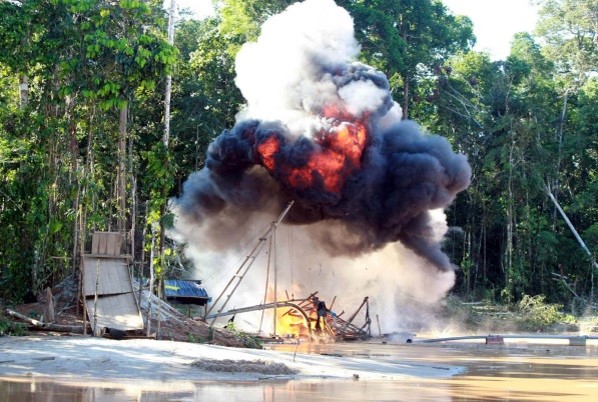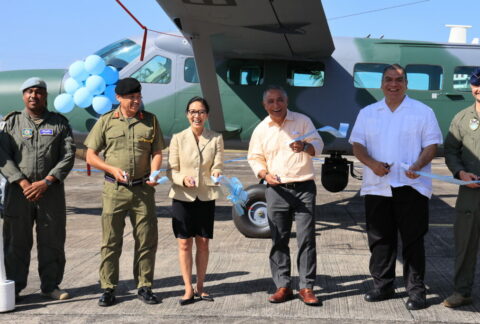The Peruvian Navy (MGP, in Spanish) began 2018 dealing blows to illegal mining in the Madre de Dios jungle region, in the southeast of Peru. Through the General Directorate of Captainships and Coast Guard, MGP conducted several operations on the Malinowski River, near the Tambopata national reserve, from January 8th-10th. During patrols of the river and its tributaries, coast guard units detected illegal mining activity.
“We made an operations plan,” said to Diálogo MGP Lieutenant Junior Grade Jonathan Novoa Cabrera, assigned to the Coast Guard Captaincy of Puerto Maldonado, the capital of the Madre de Dios region. “We located the spots, and members of both the Navy and the Attorney General’s office entered by foot from the Malinowski River.”
The operations were successful. Units destroyed a clandestine mining campsite, 15 suction pumps, 17 engines, six mining rafts, and a chainsaw.
MGP reinforcements
Illegal mining in the vicinity of the Tambopata reserve dates back many years. The National Service of Natural Protected Areas (SERNANP, in Spanish)—a subordinate body of the Peruvian Ministry of Environment—detected illicit activity in the reserve in early 2000. By 2015, the criminals had invaded the reserve itself, prompting SERNANP to request MGP reinforcement.
“In this scenario, and with the requirements from the Ministry of the Environment, through SERNANP, the Navy entered the Tambopata National Reserve permanently,” MGP Captain Eduardo Silva Marzuka, head of the Coast Guard Operations Command, told Diálogo. “They envisioned a two-part strategy: tackle illegal mining itself around the Malinowski River, and cut off illegal smuggling of supplies, fuel, and chemicals through the rivers.”
To put the plan into action, MGP created a unit dedicated to eradicating illegal mining in the area of the Tambopata Reserve. The group, whose personnel alternates twice a month, set up at Las Palmeras base in the town of Mazuko, on the edge of the reserve. The unit also counts on the support of the Puerto Maldonado Coast Guard Captaincy.
“The operations area is made up of the Inambari River and the Malinowski River,” Capt. Silva said. “It also [includes] the other Madre de Dios and Tambopata rivers, where operations against illegal mining are also carried out.”
Devastating activity

Illegal mining has a huge impact on the Peruvian environment. The deforestation that results from the activity devastates the Amazon rainforest, and the use of mercury in the extraction process pollutes rivers and harms the population.
According to the Monitoring of the Andean Amazon Project (MAAP), an NGO of the United States, Peru, Colombia, and Ecuador, Peru lost an estimated 143,500 hectares of forest in 2017. The Madre de Dios region, the MAAP indicated, is one of the main deforestation zones.
With the increase in the price of gold on the international market, illegal mining became more mechanized and industrialized. The work of MGP evolved to detect campsites and destroy equipment used, as well as monitor the transport of chemical supplies and fuel used in this activity.
“In the Inambari [River], the illegal transport of fuel is something that goes from Puno [city in the southeast of Peru] to the town of Mazuko every day,” said MGP Chief Warrant Officer 2 Ronald Sierra, assigned to Las Palmeras base. Jungle operations are not only demanding, but also risky. “On one occasion there were shots from breech-loading arms,” CWO 2 Sierra said about the January operations.
Successful efforts
With MGP presence, invaded areas reduced notably. Although deforestation continues in Madre de Dios, MAAP indicated that forest loss in 2017 was the lowest in five years. According to data from the Tambopata Reserve, 95 percent of the areas invaded, or 721 hectares, were recovered.
In 2017, MGP destroyed 11 campsites, 431 mining rafts, 26 dredges, and more than 1,000 different pieces of equipment, such as engines, suction pumps, and generators, among others, in the Madre de Dios region. The Navy also seized more than 23,000 gallons of fuel and arrested 35 people.
“This is quite a considerable effort because we have dedicated a group of people to permanently combat [illegal mining] in the Tambopata National Reserve,” Capt. Silva concluded. “That means travel expenses, equipment that we implement all year long […] because our goal is to completely free [the area] from illegal mining.”









